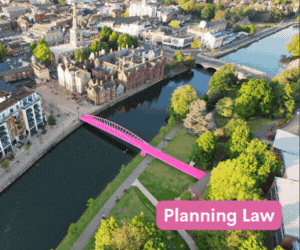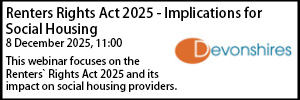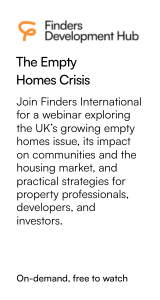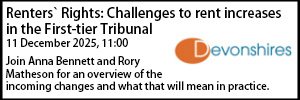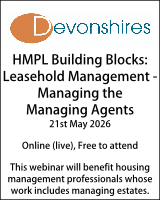Right to buy fraud – an overview of the criminal dimension
- Details
Andrew Lane looks at the potential for criminal proceedings in relation to false application for the right to buy.
Local authorities have long been able to sell to their tenants the council home provided (since 1936). For example, there were nearly 46,000 such sales in 1972. However the practice really took off and the ‘right to buy’ acquired its name following the introduction of the Housing Act 1980 in the first Thatcher government.
The significant discounts on offer made it a popular option for many tenants although there was always a concern about the depletion of stock and potential for family exploitation of elderly tenants. Scotland ended this right with effect from 31 July 2016 and Wales followed suit on 26 January 2019. In England, last year saw the Housing (Right to Buy) (Limits on Discount) (England) Order 2024/1073 which reduced the discounts significantly to 2012 levels.
The high levels of discount formerly available also meant that there was a real financial incentive to apply and this almost inevitably meant that whilst the vast majority of applicants are honest there would be some who even where there was no right they would still “chance their arm”. As the National Housing Federation said in March 2016:
“Since the discounts for the statutory right to buy (RTB) scheme were increased in 2012 there has been a reported increase in suspected RTB fraud. This has largely been driven by the potential for profit created through a combination of large discounts and increasing property values, particularly in high value areas.”
I well remember a case in my early years of practice where the tenant had ‘jumped the gun’ and moved out of his council property to live with his partner months before his right to buy application would have concluded. Instead of enjoying the right he become the subject to an outright possession order reliant on a notice to quit.
It can, of course, be a criminal offence if the right to buy is pursued based on false information. To give one example, the London Borough of Enfield warns:
“All applications will be checked by our Counter Fraud Investigation Team. If you apply and give false or misleading information, or withhold information, you may be prosecuted under the Fraud Act 2006, with a maximum sentence of 10 years or an unlimited fine or both.”
To put that in its legislative context, the Fraud Act 2006 provides:
1 Fraud
(1) A person is guilty of fraud if he is in breach of any of the sections listed in subsection (2) (which provide for different ways of committing the offence).
(2) The sections are—
(a) section 2 (fraud by false representation),
(b) section 3 (fraud by failing to disclose information), and
(c) section 4 (fraud by abuse of position).
(3) A person who is guilty of fraud is liable—
(a) on summary conviction, to imprisonment for a term not exceeding [F1the general limit in a magistrates’ court]or to a fine not exceeding the statutory maximum (or to both);
(b) on conviction on indictment, to imprisonment for a term not exceeding 10 years or to a fine (or to both).
(4) Subsection (3)(a) applies in relation to Northern Ireland as if the reference to 12 months were a reference to 6 months.
2 Fraud by false representation
(1) A person is in breach of this section if he—
(a) dishonestly makes a false representation, and
(b) intends, by making the representation—
(i) to make a gain for himself or another, or
(ii) to cause loss to another or to expose another to a risk of loss.
(2) A representation is false if—
(a) it is untrue or misleading, and
(b) the person making it knows that it is, or might be, untrue or misleading.
(3) “Representation” means any representation as to fact or law, including a representation as to the state of mind of—
(a) the person making the representation, or
(b) any other person.
(4) A representation may be express or implied.
(5) For the purposes of this section a representation may be regarded as made if it (or anything implying it) is submitted in any form to any system or device designed to receive, convey or respond to communications (with or without human intervention).
3 Fraud by failing to disclose information
A person is in breach of this section if he—
(a) dishonestly fails to disclose to another person information which he is under a legal duty to disclose, and
(b) intends, by failing to disclose the information—
(i) to make a gain for himself or another, or
(ii) to cause loss to another or to expose another to a risk of loss.
In March of this year the London Borough of Barking & Dagenham reported on a successful prosecution they had brought against one of their tenants who had misled them when seeking to exercise the right to buy his 3-bedroom council property.
This followed on from the news of the former London Borough of Islington tenant who was ordered to pay back over £260,000 Proceeds of Crime Act compensation and costs after he was found to have withheld the information that he had bought a 3-bedroom home before being allocated council accommodation. This fraud was discovered when he applied to exercise the right to buy.
The best illustration of the pitfalls of false right to buy applications is seen by consideration of an interesting Court of Appeal case heard in 2023 – R v Monica Williams [2023] EWCA Crim 1236:
- 2006 local authority tenancy
- 2010, 2016 right to buy applications
- Local authority investigated due to suspicions
- In February and April of 2019, a tenancy audit officer made 6 unannounced visits to property, finding nobody there.
- It was ascertained that Land Registry records showed that from 25 November 1988 the appellant and someone else were the registered owners of a property in Ilford. From 23 September 1998 the appellant’s Student and Graduate Services account was registered to that address and on 7 February 2002 a mortgage application form was submitted to the Abbey National in respect of that property in the names of the same other person and the appellant purporting to bear their signatures. At the time the property was mortgaged to Santander PLC.
- Land Registry records further showed that from 25 April 2003 the appellant and other person were the registered owners of another property also in Ilford. On 26 February 2006 a personal bank account in the appellant’s name was registered at this address. In February 2018 a flexible savings account was registered at number 76 South Park Road in the names of the appellant and the other person, and children’s savings accounts were also registered at this address in the names of the appellant and each of her children. At the time of trial this property had a charge in favour of The Mortgages Business PLC.
- On 16 May 2019 the tenancy audit officer went to this other property where a woman answered the door but declined to produce ID and shut the door on him.
- He later went back to the Council property. On a couple of visits he found nobody at home. When he attended on 3 June 2019 by appointment, he was met by a woman wearing a blonde wig whom he said was the same woman who had answered the door in the owner occupied property 18 days earlier. He said he had seen that same woman leaving the Council property that evening without the wig. The prosecution case was that this woman was the appellant.
The tenant claimed in interview that the other properties had been put into her name without her knowledge, and that a friend completed her right to buy application for her. She was acquitted on one count:
“Count 1 alleged that, dishonestly and intending to make a gain for herself or another the appellant failed between 15 January 2007 and 16 May 2019 to disclose to the Council information which she had a legal duty to disclose namely that she had stopped using 44 Etta Street as her only or principal home.”
but convicted on the other:
“Count 2 alleged that on or about 3 January 2016 the appellant committed fraud in that, dishonestly and intending thereby to make a gain for herself or another, she made a representation within her Right to Buy application which she knew to be untrue or misleading, namely that she was occupying Etta Street as her only or main home.”
These may seem contradictory positions, as the appellant maintained, but the Court of Appeal disagreed and explained:
“(1) The one critical factual issue in the case, as everyone agreed, was whether the appellant was living at Etta Street as her main residence throughout the period covered by count 1. If the jury found that this was or might be the case the appellant was entitled to be acquitted on both counts. She could not be found guilty of any failure to disclose, nor could the representations she made in the Right to Buy form be found to be false. The appellant could not be convicted on either count unless the jury was sure that she was not living at Etta Street as her main residence at the time stated in that count.
(2) If, on the other hand, the jury were sure that Etta Street was not the appellant’s main residence throughout the period specified in count 1 a finding of non-disclosure for the purposes of that count was logically inevitable, and if the jury were sure she was not living there on 3 January 2016 a finding of misrepresentation for the purposes of count 2 was equally inevitable.
(3) But that was not the whole picture. Even on these assumptions count 2 would still raise the further issues of whether any positive misrepresentation was not just false but also dishonest and made for to gain. Count 1 would raise the further issues of whether any passive failure to disclose the true position amounted to a breach of a legal duty and, if it did, whether that was dishonest conduct engaged in with a view to gain.
(4) On some of those matters the appellant had made concessions in the course of her evidence. But these were not binding on the jury, nor did the judge direct them to that effect. He did direct them to focus on what we have described as the critical factual issue. But he did not direct them that if they were persuaded of the prosecution’s case on that issue they must convict on each count. What he said about that scenario was that in the light of the concessions made by the appellant it “would be open” to the jury to convict.
(5) There was evidence on the basis of which a reasonable jury could be sure that Etta Street was not the appellant’s main residence on 3 January 2016. As a matter of logic, a jury sure of that would have to conclude that the representation made in the appellant’s Right to Buy form was false. It will be irrational to do otherwise. Although it did not follow necessarily, that jury might well conclude that the representation was not only false but also dishonest, and made with a view to gain, so that count 2 was made out.
(6) That analysis would explain the verdict on count 2.
(7) The same jury might, however, have been unpersuaded that the appellant had a positive legal duty to disclose to the Council that she was non-resident on 3 January 2016, or indeed any other date within the period covered by count 1. This was a question of law which seems never to have received any detailed attention from Counsel or the judge in court during the trial. We have explored the issue in the course of argument today. It has emerged from scrutiny of the trial bundle by counsel for the appellant that there was a term expressly imposing on her an obligation to disclose within 28 days any long-term change in the persons occupying the property. But we have not been shown that this was drawn to the jury’s attention, other than being placed in the jury bundle. It seems that all the jury was ever told about the issue was that the prosecution’s case was that the duty arose because residing somewhere else would have affected the appellant’s right to remain as a tenant of Etta Street, and that the defendant did not dispute this. The judge did not direct the jury that they must accept the prosecution’s point of law.
(8) A rational jury might, further or alternatively, have been unsure that the appellant was aware that she had any legal duty to disclose the fact of her non-residence at Etta Street. The jury might consequently or for some other reason, have been uncertain that the appellant’s failure to make such a disclosure was dishonest. We have not been shown the detail of the concessions she made on the issue of dishonesty. But it is clear that her concessions on that issue must necessarily have been hypothetical and so far as the information before us goes, they appear to have gone only to count 2. The issue of dishonesty on that count was not the same as the issue on count 1.
(9) These considerations would explain the verdict on count 1.”
Andrew Lane is a public law and housing barrister at Cornerstone Barristers. This article first appeared on the Cornerstone on Social Housing Fraud blog.



















